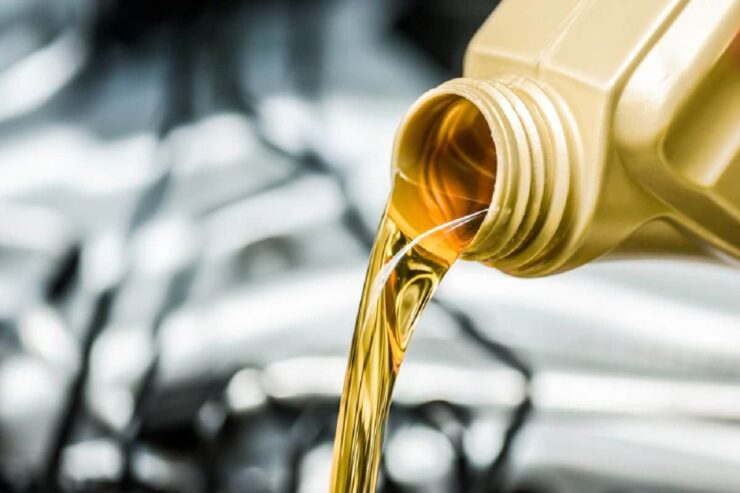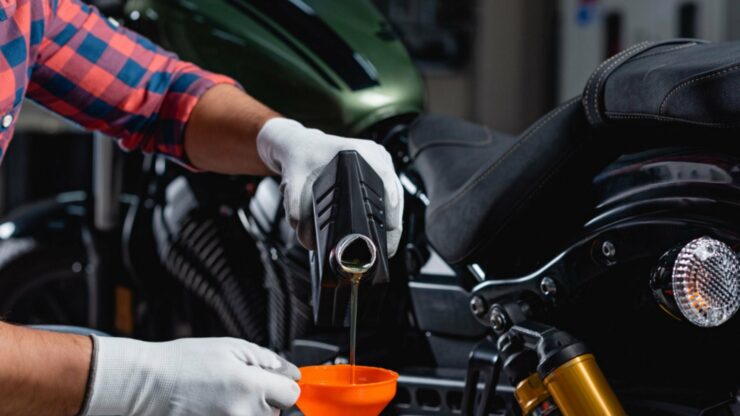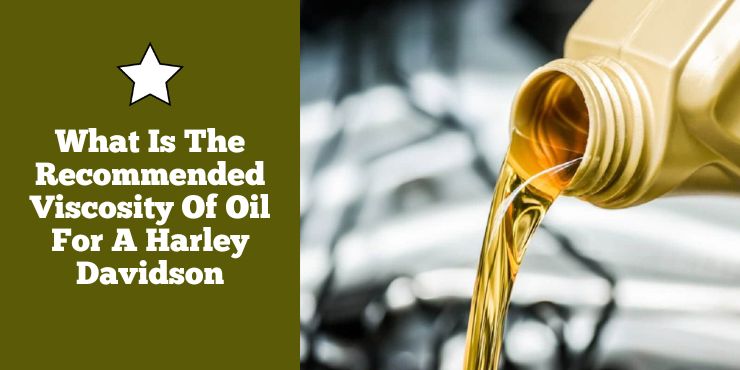Are you a Harley-Davidson enthusiast looking to make sure you’re using the right oil for your engine? If so, you’ve come to the right place!
The recommended viscosity for Harley-Davidson engines is typically 20W-50, but consult your owner’s manual as it may vary based on your specific model and climate.
In this article, we’ll be discussing the recommended viscosity of oil for a Harley-Davidson and the importance of using the correct oil for your vehicle. Read on to find out more about this essential motorcycle maintenance topic!
Different causes of viscosity variance in motorcycle oil
Harley-Davidson bikes are known for their iconic designs, powerful engines, and thrilling riding experiences. For Harley-Davidson motorcycle riders, choosing the right engine oil will be important for maintaining optimal engine performance and prolonging the life of their beloved two-wheeled companions. Motorcycle oils come in different types, each with specific properties to cater to different engine designs and riding conditions.
>>> Click here to read our review of the Best Oil For Harley-Davidson <<<
One of the critical characteristics of motorcycle oil is viscosity, which plays a major role in its performance across different temperatures. Viscosity or the oil’s resistance to flow is a critical property that can be affected by different values. Here are the different causes of viscosity variance in motorcycle oil.
Types of motorcycle oil
The type of motorcycle oil used will play in role in causing viscosity variance in motorcycle oil. Mineral oil is derived from crude oil and refined through traditional processes. It is cost-effective but it does have certain limitations in terms of high-temperature performance and durability.
Synthetic oil is chemically engineered in a lab, as it is capable of offering superior lubrication and performance characteristics. Its uniform molecular structure will allow it to flow more smoothly, even in extreme temperatures, making it ideal for high-performance engines.
Semi-synthetic oil is a blend of mineral oil and synthetic oil. It strikes the right balance between cost-effectiveness and performance, making it suitable for a wide range of motorcycle engines.
Impact of temperature on viscosity
Viscosity refers to a fluid’s resistance to flow and it is an important property of motorcycle oil. The viscosity of oil tends to change with temperature. It becomes thinner and lower in viscosity at higher temperatures. Meanwhile, at colder temperatures, the oil becomes thicker and higher in viscosity.
The Society of Automotive Engineers (SAE) has established a grading system to indicate the viscosity of motor oils at specific temperatures. For instance, you might see oil labeled as “SAE 10W-40” where the 10W denotes the winter viscosity (cold temperature performance) while the “40” represents the summer viscosity (high-temperature performance).
At lower temperatures, oil with lower viscosity flows more easily, ensuring smoother engine startups and efficient lubrication in cold conditions. Meanwhile, higher viscosity at higher temperatures provides better protection and lubrication for engines operating under hot conditions. The goal will be to strike a balance between the two extremes and select an oil viscosity that suits the engine design and riding conditions.
Oil additives
Oil additives are chemical compounds added to the base oil to enhance its performance and properties. There are different additives that impact the oil’s viscosity in various ways such as viscosity index improvers, friction modifiers, detergents and dispersants, and more.
Viscosity Index Improvers are additives that help stabilize the oil’s viscosity across a wide temperature range. They prevent significant changes in viscosity due to temperature fluctuations, ensuring consistent engine protection in different weather conditions.
Detergents and dispersants keep the engine clean by preventing the formation of deposits and sludge. However, they also impact the oil’s viscosity if they form excessive residue, resulting in a change in the oil’s flow properties.
Friction Modifiers reduce friction between moving parts, improving fuel efficiency and engine performance. However, an excessive amount of these additives can result in a decrease in viscosity, leading to oil thinning and potential engine damage.
Oil degradation
Over time, motorcycle oil can degrade because of exposure to high temperatures, engine stress, and contaminants. The oil’s chemical composition can change, resulting in a decrease in viscosity and a reduction in its ability to protect the engine effectively. As the oil ages, it might also form sludge and deposits, further impacting its flow properties and engine performance.
To prevent oil degradation, it is important to adhere to the recommended oil change intervals for your specific Harley-Davidson model. Regular oil changes will ensure that fresh, high-quality oil is circulating through the engine, providing optimal lubrication and protection.
Contamination
Contamination of motorcycle oil can result in changes in viscosity. Contaminants such as dirt, fuel, and coolant can enter the oil system, altering its flow properties. For an instant, coolant leakage into the oil can result in a significant decrease in viscosity, affecting the oil’s ability to lubricate effectively.
To prevent viscosity variance due to contamination, it’ll be essential to inspect and maintain the bike’s cooling system, air filter, and fuel system regularly. Regular oil and filter changes can also help remove contaminants and maintain optimal oil viscosity.

What is the recommended viscosity of oil for a Harley-Davidson?
Harley-Davidson bikes are a symbol of freedom, power, and exhilarating rides on the open road. For ensuring you get the best performance and longevity of these iconic machines, choosing the right motorcycle oil is of utmost importance. Viscosity, the measure of an oil’s resistance to flow, is an important factor in determining the oil’s ability to protect and lubricate the engine effectively. As a Harley-Davidson rider, a common question you might have in the context of viscosity will be what is the recommended viscosity of oil for a Harley-Davidson bike? Finding the recommended viscosity of motorcycle oil for your Harley will be essential for ensuring optimal performance in various weather conditions and riding scenarios.
Viscosity is generally indicated by a series of numbers and letters, such as “10W-40” or “20W-50” and is referred to as the oil’s grade. The “W” stands for winter and indicates the oil’s cold temperature performance whereas the second number represents the oil’s viscosity at operating temperatures.
The first number (winter viscosity) will measure how thin or thick the oil is at low temperatures. Lower numbers like 5W or 10W indicate thinner oil that flows more freely during cold starts, providing better engine protection during startup.
The second number (operating temperature viscosity) will show the oil’s thickness at higher temperatures. Higher numbers such as 40 or 50, will signify thicker oil that maintains proper lubrication and protection when the engine is operating at normal temperatures.
Now comes the question what is the recommended viscosity of oil for a Harley-Davidson bike? The recommended viscosity of motorcycle oil for Harley-Davidson motorcycles can vary depending on the specific model, engine type, and intended usage. Harley-Davidson offers guidelines for selecting the appropriate viscosity based on various factors, including climate and typical riding conditions.
For most Harley-Davidson models having air-cooled V-twin engines, multi-grade oils such as 20W-50 are commonly recommended. This viscosity offers the right balance between cold-start protection and high-temperature performance, making it ideal for a wide range of weather conditions and riding styles.
The 20W-50 grade oil is commonly used in Harley-Davidson motorcycles, especially in warmer climates or during the summer months. It offers adequate cold-temperature flow for easy starting and excellent protection at higher operating temperatures.
Some Harley-Davidson bikes might also be compatible with 15W-50 oil, especially for riding in milder climates or during transitional seasons. This viscosity offers improved cold-temperature performance while maintaining adequate protection in hot conditions.

General considerations to remember when selecting viscosity in motorcycle oil
Selecting motorcycle oil with the right viscosity is an important decision that can significantly impact the performance and longevity of your Harley-Davidson motorcycle. Viscosity is the measure of an oil’s resistance to flow and it plays a significant role in the engine’s lubrication and protection, particularly in different weather conditions and riding scenarios. When choosing the viscosity for your Harley-Davidson motorcycle oil, there are a number of considerations you must remember to ensure the best results and a smooth riding experience. Here are some of them.
Climate and temperature range
One of the most important factors that you should consider when selecting the viscosity of motorcycle oil is the climate and temperature range in your riding region. Different viscosities perform differently in varying temperatures.
For hotter climates or during the summer months, you should go for oils with higher summer viscosity, such as 50W. Thicker oils offer better protection and lubrication at higher operating temperatures, providing enhanced engine performance and protection.
For older climates or during the winter months, you should consider oils with lower winter viscosity, such as 5W or 10W. These oils flow more easily during cold starts, providing quick lubrication to protect vital engine components during startup.
Model and engine type
Different Harley-Davidson models might have specific oil viscosity requirements based on their engine type and design. You should refer to your bike’s owner’s manual or consult with Harley-Davidson experts for determining the recommended viscosity for your specific bike model. High-performance engines might have different viscosity needs compared to standard engines. This is why it will be important to use the recommended grade for your engine type.
Riding style and conditions
Consider your typical riding style and conditions when choosing the oil viscosity. If you frequently engage in high-performance riding, ride in heavy traffic with frequent stops and starts, or carry heavy loads, a slightly higher viscosity will provide extra protection for your engine.
Multi-grade oils and viscosity index improvers
Multi-grade oils, such as 20W-50 are popular for many Harley-Davidson motorcycles. These oils contain viscosity index improvers, which help in stabilizing the oil’s viscosity across a wide temperature range. They provide the benefits of both low winter viscosity for easy starts and high summer viscosity for better engine protection during hot conditions.
Manufacturer specifications and oil quality
You must refer to the manufacturer’s specifications and guidelines for selecting the appropriate viscosity for your Harley-Davidson motorcycle. Following the manufacturer’s recommendations will ensure that you’re using the right oil grade for your specific motorcycle model.
Additionally, use high-quality oils from reputable brands that meet or exceed the manufacturer’s specifications. Quality oils with the right additives will provide enhanced engine protection and overall performance.
Benefits of using the recommended viscosity of oil
Harley-Davidson bikes are more than just machines. These bikes represent a lifestyle and a passion for the open road. To ensure that your Harley-Davidson motorcycle continues to provide you with the ultimate riding experience, proper maintenance will be important. Choosing the right motorcycle oil option with the recommended viscosity will be an important decision that leads to optimal efficiency, longevity, and engine protection. Here are some of the benefits of using the recommended viscosity for motorcycle oil in your Harley-Davidson bikes.
#1. Enhanced efficiency
Efficiency is an important aspect of any bike’s performance and the right viscosity oil will play a significant role in achieving it. The recommended viscosity for your Harley-Davidson motorcycle will allow the engine to function smoothly and efficiently in various weather conditions.
During cold starts, low winter viscosity will ensure that the oil flows quickly and provides immediate lubrication to critical engine components, reducing wear and tear.
In contrast, at higher temperatures, the recommended summer viscosity will maintain its protective qualities, preventing engine parts from grinding against each other due to excess friction. A well-lubricated engine will operate more efficiently, resulting in improved fuel economy and overall performance.
#2. Prolonged longevity
Longevity is another vital factor for any Harley-Davidson rider and using the oil with the recommended viscosity will significantly contribute to your bike’s engine life. This oil will act as a protective barrier between moving parts, preventing metal-to-metal contact and reducing wear.
Over time, incorrect viscosity or using substandard oil can result in accelerated engine wear, which might result in expensive repairs and shortened engine life.
Using oil with the recommended viscosity will ensure that your engine receives proper lubrication, reducing friction and minimizing wear on critical components such as the pistons, camshafts, and crankshaft. As a result, your bike’s engine can operate optimally for more extended periods, providing you with many years of reliable riding.
#3. Optimal engine protection
Another crucial benefit of using the recommended viscosity motorcycle oil will be the enhanced engine protection it provides. The oil forms a protective film over engine parts, preventing them from grinding together and causing excessive heat and friction. The right viscosity will ensure that the oil can flow and circulate efficiently through all parts of the engine, even in extreme conditions.
In high-performance Harley-Davidson models, using the recommended viscosity can be quite critical to handle the increased power and stress placed on the engine during spirited riding. Properly lubricated components reduce the risk of engine damage and improve the engine’s ability to handle the demands of the road.
#4. Reduced maintenance costs
Using oil with the recommended viscosity can also result in reduced maintenance costs in the long run. Proper engine lubrication will prevent excessive wear and reduce the likelihood of engine issues, which can translate to fewer repairs and lower maintenance expenses over time.
Harley-Davidson motorcycles are designed to work optimally with the recommended viscosity oil. Using the right oil will ensure that your motorcycle operates as intended, reducing the chances of issues arising from using the wrong type of oil.
#5. Improved performance
Harley-Davidson motorcycles are all about power and performance, and using the oil with the recommended viscosity will contribute to their optimum performance. Proper engine lubrication will allow the engine to run smoothly, maximizing its power output and responsiveness.
For riders who seek the thrill of acceleration and enjoy pushing their motorcycles to the limit the recommended viscosity oil ensures that the engine can handle the demands of high-performance riding, providing a thrilling and exhilarating experience on the road.
#6. Manufacturer confidence
Following the manufacturer’s recommendations and using the oil with the recommended viscosity will instill confidence in your bike’s performance. The manufacturer has carefully tested and selected the appropriate oil grade for each specific model to ensure optimal performance and engine protection.
Using the oil with the recommended viscosity will not only keep your bike running at its best but also maintain the manufacturer’s warranty coverage. It demonstrates that you’re taking the necessary steps to care for your motorcycle and adhere to proper maintenance guidelines.

How to change the motorcycle oil in your Harley-Davidson bike?
Regular oil changes are an important part of motorcycle maintenance, especially for Harley-Davidson motorcycles that deliver powerful performance and thrilling rides. Changing the oil in your Harley-Davidson bike ensures that the engine remains well-lubricated and protected, optimizing its longevity and performance. While it might seem like a slightly daunting task, with the right tools and proper instructions, changing the oil will be a straightforward and rewarding process. Here are the steps you need to follow for changing the motorcycle oil in your Harley-Davidson bike –
Step 1: Gather the tools and materials
The first step in the process to change the oil in your bike involves gathering the required tools and materials. Here is the list of tools and materials you will require –
- A socket set or wrench for removing the drain plug
- A drain pan for catching the old oil
- An oil filter wrench for replacing the oil filter
- New oil and an oil filter compatible with your Harley-Davidson model
- Safety gear, including safety goggles and gloves
Step 2: Warm up the engine and position the bike
Start your Harley-Davidson motorcycle and allow it to run for a few minutes to warm up the engine. Warm oil flows more freely, which makes it easier to drain the old oil. Park your bike on a level surface for ensuring stability and to facilitate proper drainage of the old oil.
Step 3: Drain the old oil
Locate the oil drain plug, typically located on the underside of the engine. Place the drain pan beneath the drain plug and use the socket set or wrench to loosen and remove the plug. You should allow the old oil to drain completely into the pan. While the oil is draining, inspect the drain plug and its washer for wear or damage. Replace the washer if needed.
Step 4: Replace the oil filter
Locate the oil filter, which will be positioned near the drain plug. Use the oil filter wrench for removing the old oil filter. Take care that you don’t spill oil during this process. Before you install the new filter, apply a thin layer of clean oil to the rubber gasket on the new filter to create a good seal. Hand-tighten the new filter firmly but avoid overtightening.
Step 5: Refill with new oil
Check your Harley-Davidson bike’s owner’s manual to determine the recommended oil capacity and type for your specific model. Use a funnel for adding the new oil to the engine through the oil fill cap. Pour in the correct amount of oil but avoid overfilling. Allow a few moments for the oil to settle, then recheck the oil level using the dipstick.
Step 6: Check for leaks
Once you have completed the oil change, start the engine to let it run for a few minutes. Check for any signs of oil leaks around the drain plug and oil filter. You should address any leaks immediately to prevent potential engine damage.
Step 9: Properly dispose of old oil
Properly dispose of the old oil and used oil filter. Many auto part stores or recycling centers accept used oil for recycling. You shouldn’t dispose of used oil inappropriately as it can harm the environment.
FAQ
What type of oil should I use for my Harley-Davidson?
Harley-Davidson recommends using 10W-40 oil with a viscosity of SAE 40 or higher for most of their engines. For hotter climates, they recommend using 20W-50 oil to help reduce engine wear.
What are the benefits of using the recommended oil viscosity?
Using the recommended oil viscosity for your Harley-Davidson is important for ensuring optimal engine performance. The correct viscosity oil helps provide better lubrication, reduces engine wear, and helps maintain engine temperature.
What happens if I use an oil viscosity that is not recommended?
Using an oil viscosity that is not recommended could lead to decreased engine performance and increased engine wear. It could also lead to higher engine temperatures, which could result in increased fuel consumption and exhaust emissions.
>>> Read more about Oil for Harley-Davidson <<<

